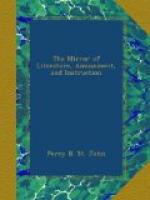The body of the King being embalmed, under the orders of Herbert and bishop Juxon, was removed to St. James’s. The usurpers of the government refused permission to bury it in Henry the VII.’s Chapel, from a dread of the indignation of the crowds who would assemble on so solemn and interesting an occasion; but, at last, after some deliberation, the council allowed it to be privately interred in St. George’s Chapel at Windsor, provided the expenses of the funeral should not exceed five hundred pounds. The last duties of love and respect were (according to Charles’s express desire) paid to their sovereign’s corpse by the Duke of Richmond, the Marquess of Hertford, Lord Southampton, Lord Lindsey, the Bishop of London, Herbert, and Mildmay, who, on producing a vote of the Commons, were admitted by Whichcote, the Governor of Windsor Castle, to the chapel. When the body was carried out of St. George’s Hall, the sky was serene and clear; but presently a storm of snow fell so fast, that before it reached the chapel the pall and the mourners were entirely whitened. When the bishop proposed to read the burial service according to the rites of the Church of England, this fanatical governor roughly refused, saying, “that that Common Prayer Book was put down, and he would not suffer it to be used in that garrison where he commanded.” Clarendon thus describes, with graphic simplicity, the sad scene to its close:—
“But when they entered into it (the chapel), which they had been so well acquainted with, they found it so altered and transformed, all inscriptions and those landmarks pulled down, by which all men knew every particular place in that church, and such a dismal mutation over the whole that they knew not where they where; nor was there one old officer that had belonged to it, or knew where our Princes had used to be interred. At last there was a fellow of the town who undertook to tell them the place where, he said, ’there was a vault in which King Harry the Eighth and Queen Jane Seymour were interred.’ As near that place as could conveniently be they caused the grave to be made. There the King’s body was laid, without any words, or other ceremonies, than the tears and sighs of the few beholders. Upon the coffin was a plate of silver fixed, with these words only, ‘King Charles, 1648.’ When the coffin was put in, the black velvet pall that had covered it was thrown over it, and then the earth thrown in; which the governor staid to see perfectly done, and then took the keys of the church.
“Owing to the privacy of this interment, doubts were at the time current as to its having actually taken place. It was asserted that the King’s body was buried in the sand at Whitehall; and Aubrey states a report, that the coffin carried to Windsor was filled with rubbish and brick-bats. These doubts were entirely removed by the opening of the coffin (which was found where Clarendon described it,) in the presence of George the Fourth, then Prince




